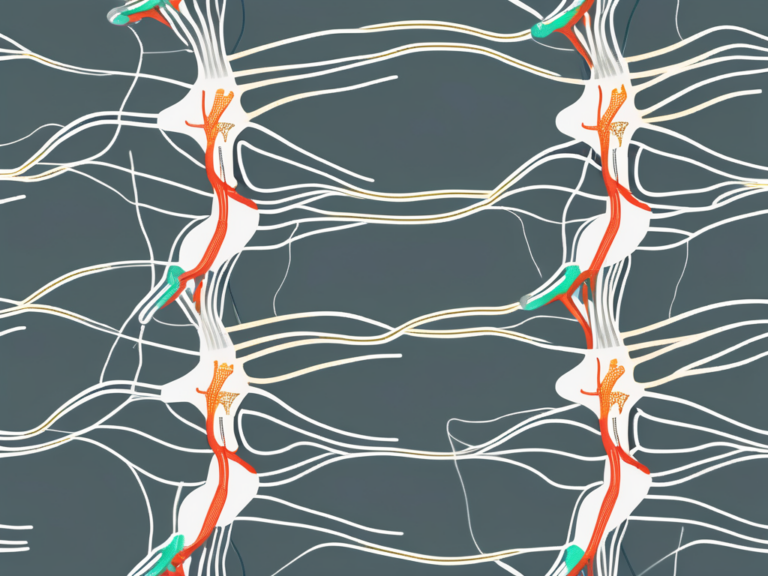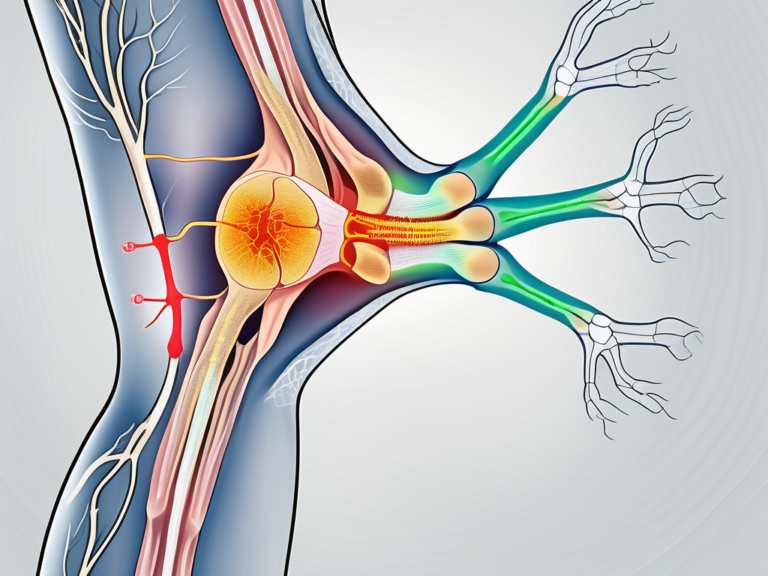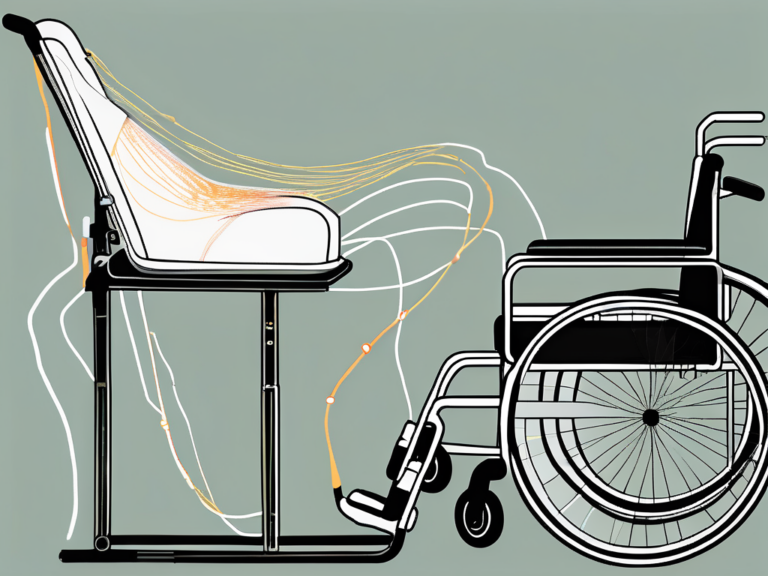Which Nerve Roots Form the Sacral Plexus?
The sacral plexus is an intricate network of nerves located in the lower back region, specifically in the sacrum. It plays a crucial role in the functioning of the lower limbs and the pelvic region. To understand the nerve roots that form the sacral plexus, it is essential to have a basic understanding of the nervous system.
Understanding the Nervous System
The nervous system is a complex network of nerves and cells that controls and coordinates the actions of the body. It is divided into two main parts: the central nervous system (CNS) and the peripheral nervous system (PNS). The CNS consists of the brain and spinal cord, while the PNS includes all the nerves outside of the CNS.
The central nervous system, composed of the brain and spinal cord, acts as the command center for the entire body. It receives and processes sensory information from the peripheral nervous system, and then sends out motor commands to initiate appropriate responses. The brain, with its billions of neurons, is responsible for higher cognitive functions, such as memory, learning, and decision-making. The spinal cord, on the other hand, serves as a conduit for information flow between the brain and the rest of the body.
The peripheral nervous system, consisting of nerves that extend from the CNS to every part of the body, plays a vital role in relaying information between the brain and various organs, muscles, and tissues. These nerves are like electrical cables, transmitting signals in the form of electrical impulses. The PNS can be further divided into the somatic nervous system and the autonomic nervous system.
The somatic nervous system controls voluntary movements and sensory perception. It allows us to consciously move our muscles, feel sensations such as touch and pain, and perceive the world around us. The autonomic nervous system, on the other hand, regulates involuntary processes, such as heart rate, digestion, and breathing. It operates without conscious control and ensures the body functions properly without our conscious effort.
The Role of Nerve Roots in the Body
Nerve roots are bundles of nerve fibers that emerge from the spinal cord, forming the foundation of the peripheral nervous system. They branch out, connecting to various parts of the body, allowing for the transmission of signals between the brain and different body parts. Each nerve root carries both motor and sensory information.
Motor information refers to signals that initiate muscle contractions and control voluntary movements. For example, when you decide to lift your arm, the motor information travels from the brain through the nerve roots to the muscles responsible for arm movement. Sensory information, on the other hand, involves signals from sensory receptors in the body that provide information about touch, temperature, pain, and other sensations. These sensory signals travel from the body to the brain through the nerve roots, allowing us to perceive and respond to our environment.
The nerve roots are like the communication highways of the body, ensuring that signals are transmitted accurately and efficiently. They are responsible for the coordination of movements, reflexes, and sensory perception. Any damage or disruption to the nerve roots can lead to a variety of neurological symptoms, such as muscle weakness, numbness, or loss of sensation in specific areas of the body.
The Importance of the Sacral Plexus
The sacral plexus is a network of nerves that arises from the lower part of the spinal cord, specifically the sacral region. It is responsible for innervating the lower limbs, controlling their movement, and providing sensory feedback. The sacral plexus is a crucial component of the overall functioning of the body, as it enables us to walk, run, jump, and perform various activities involving the lower extremities.
Within the sacral plexus, there are multiple nerve roots that come together and form a complex web of interconnected nerves. These nerves branch out and supply motor signals to the muscles of the legs and feet, allowing us to move and maintain balance. Additionally, they carry sensory information from the lower limbs back to the brain, providing us with a sense of touch, temperature, and proprioception (awareness of body position).
Any disruption or damage to the sacral plexus can result in significant functional impairments. For example, injuries to the lower back or pelvis can affect the nerve roots within the sacral plexus, leading to weakness or paralysis of the lower limbs, loss of sensation, or altered reflexes. Rehabilitation and targeted therapies are often necessary to restore function and improve quality of life for individuals with sacral plexus injuries.
Anatomy of the Sacral Plexus
The sacral plexus, a vital component of the nervous system, consists of multiple intricate structures that work in perfect harmony to carry out its functions. Understanding the detailed anatomy of the sacral plexus is fundamental to comprehend the nerve roots involved and their corresponding roles.
The sacral plexus is a complex network formed by the fusion of nerve roots originating from the lumbar and sacral regions of the spinal cord. These nerve roots, like the threads of a tapestry, come together to create a magnificent web of interconnectedness, giving rise to the sacral plexus.
Components of the Sacral Plexus
Within the sacral plexus, a symphony of nerves and fibers work together to ensure the proper functioning of the lower limbs and pelvic region. The components of the sacral plexus are like the instruments in an orchestra, each playing a unique role in the symphony of movement and sensation.
The sacral plexus is composed of various nerve roots, including the ventral rami of the fourth and fifth lumbar nerves, as well as the first, second, third, and fourth sacral nerves. These nerve roots intertwine and merge, forming a complex network that gives rise to the sacral plexus.
Location and Structure of the Sacral Plexus
Located in the intricate landscape of the pelvic region, the sacral plexus finds its home on the anterior surface of the sacrum. Like a hidden gem, it resides deep within the bony confines of the pelvis, shielded and protected.
The sacral plexus, with its triangular-shaped structure, is a testament to the beauty of nature’s design. It is divided into two main divisions: the anterior and posterior divisions. Each division plays a distinct role in the transmission of information within the nervous system.
The anterior division of the sacral plexus primarily contains motor nerves, responsible for controlling the movement and coordination of the lower limbs. Like skilled conductors, these motor nerves orchestrate the intricate dance of muscles, enabling us to walk, run, and perform countless other movements with grace and precision.
In contrast, the posterior division of the sacral plexus carries sensory information, acting as a gateway for the transmission of sensations from the lower limbs and pelvic region. It is through this division that we experience the gentle touch of a loved one, the warmth of the sun on our skin, and the subtle nuances of the world around us.
The sacral plexus, with its awe-inspiring complexity and remarkable structure, serves as a testament to the brilliance of the human body. It is a testament to the intricate interplay of nerves, muscles, and sensations that allow us to navigate the world and experience life to its fullest.
Nerve Roots Contributing to the Sacral Plexus
The nerve roots that contribute to the formation of the sacral plexus play a vital role in the overall functioning of this complex network. Let’s take a closer look at the lumbar and sacral nerve roots involved.
The lumbar nerve roots that contribute to the sacral plexus include the fourth and fifth lumbar nerves (L4 and L5). These nerve roots merge with each other and with the fourth sacral nerve root (S4) to form the lumbosacral trunk, a key component of the sacral plexus.
The fourth and fifth lumbar nerves (L4 and L5) arise from the spinal cord in the lower back region. These nerves are responsible for transmitting motor and sensory signals to and from the lower extremities. They play a crucial role in controlling movements and sensations in the hips, thighs, and legs.
As the lumbar nerves merge with the fourth sacral nerve root (S4), they form the lumbosacral trunk. This trunk acts as a bridge between the lumbar and sacral regions of the spinal cord, allowing for the transmission of nerve signals between these two areas.
Now, let’s explore the sacral nerve roots that contribute to the sacral plexus.
The sacral nerve roots that contribute to the sacral plexus include the fifth lumbar nerve root (L5), the first, second, and third sacral nerve roots (S1, S2, and S3), as well as a portion of the fourth sacral nerve root (S4). These nerve roots combine to form the anterior and posterior divisions of the sacral plexus.
The fifth lumbar nerve root (L5) is the largest nerve root in the sacral plexus. It originates from the lower back and extends into the sacral region. This nerve root plays a crucial role in controlling the muscles and providing sensation to the buttocks, thighs, and lower legs.
The first, second, and third sacral nerve roots (S1, S2, and S3) arise from the sacral region of the spinal cord. These nerve roots are responsible for transmitting motor and sensory signals to and from the pelvic region, including the bladder, rectum, and reproductive organs.
A portion of the fourth sacral nerve root (S4) also contributes to the sacral plexus. This nerve root plays a role in controlling the muscles and providing sensation to the perineum, which is the area between the genitals and the anus.
When the lumbar and sacral nerve roots combine, they form the anterior and posterior divisions of the sacral plexus. These divisions further branch out to innervate various muscles and organs in the pelvic region, enabling essential functions such as walking, urination, and sexual activity.
Functions of the Sacral Plexus
The sacral plexus serves various essential functions in the body. Understanding these functions is crucial in recognizing the significance of the nerve roots that form the sacral plexus.
The sacral plexus, located in the pelvis, is a complex network of nerves that plays a vital role in the motor and sensory functions of the lower limbs and the pelvic region. It is formed by the fusion of the anterior rami of the spinal nerves L4, L5, S1, S2, S3, and S4. This intricate network of nerves allows for the transmission of signals between the brain and the lower extremities, facilitating movement and sensory perception.
Motor Functions of the Sacral Plexus
The motor functions of the sacral plexus involve controlling the movement of the muscles in the lower limbs and the pelvic region. It plays a pivotal role in activities such as walking, running, and maintaining balance. The nerve roots originating from the sacral plexus provide the necessary signals for muscle contraction and movement.
When we walk or run, the sacral plexus sends signals to the muscles in our legs, enabling them to contract and propel us forward. It also coordinates the movements of our pelvic muscles, allowing us to maintain balance and stability. Without the proper functioning of the sacral plexus, these essential motor functions would be compromised, leading to difficulties in mobility and coordination.
Sensory Functions of the Sacral Plexus
The sensory functions of the sacral plexus involve transmitting sensory information from the lower limbs and the pelvic region to the brain. These nerve roots carry signals related to touch, pain, temperature, and proprioception, enabling us to perceive and react to our surroundings.
When we touch a hot surface, the sensory nerve fibers of the sacral plexus immediately transmit signals to the brain, alerting us to the potential danger and triggering a reflexive withdrawal response. Similarly, when we step on a sharp object, the sacral plexus relays the sensation of pain, prompting us to remove our foot from harm’s way.
In addition to touch and pain, the sacral plexus also plays a role in temperature perception. It allows us to sense whether the environment is hot or cold, helping us adjust our clothing or seek shelter accordingly. Furthermore, proprioception, which refers to our ability to sense the position and movement of our body parts, is also facilitated by the sacral plexus. This enables us to maintain balance and coordination during various physical activities.
In conclusion, the sacral plexus is a vital component of the nervous system, responsible for crucial motor and sensory functions in the lower limbs and the pelvic region. Its intricate network of nerve roots allows for the transmission of signals that enable us to move, perceive, and interact with our environment. Understanding the functions of the sacral plexus helps us appreciate its significance in maintaining our overall well-being and quality of life.
Disorders Related to the Sacral Plexus
Disorders affecting the sacral plexus can significantly impact an individual’s quality of life and mobility. The sacral plexus is a network of nerves located in the lower back region, responsible for transmitting signals to and from the lower limbs, pelvic organs, and lower abdomen. When this complex network is disrupted or damaged, it can lead to a variety of symptoms and complications.
Understanding the symptoms, diagnosis, and treatment options for sacral plexus disorders is crucial in order to seek appropriate medical attention and improve overall well-being.
Symptoms of Sacral Plexus Disorders
The symptoms of sacral plexus disorders can vary depending on the severity and underlying cause. Common symptoms may include weakness or paralysis in the lower limbs, loss of sensation in the pelvic region and legs, difficulty walking or maintaining balance, and urinary or bowel dysfunction.
Weakness or paralysis in the lower limbs can significantly affect an individual’s ability to perform daily activities such as walking, standing, or climbing stairs. Loss of sensation in the pelvic region and legs can lead to difficulties in detecting pain, temperature, or touch, making it challenging to identify potential injuries or infections.
Difficulty walking or maintaining balance can result in frequent falls and accidents, further impacting mobility and independence. Urinary or bowel dysfunction can manifest as incontinence, retention, or constipation, causing discomfort and potential complications.
If experiencing any of these symptoms, it is crucial to consult with a medical professional for an accurate diagnosis. Early intervention and treatment can help manage symptoms and prevent further deterioration.
Diagnosis and Treatment of Sacral Plexus Disorders
Diagnosing sacral plexus disorders involves a combination of medical history evaluation, physical examination, imaging tests such as MRI or CT scans, and nerve conduction studies. Medical history evaluation helps identify any potential risk factors or previous injuries that may have contributed to the development of the disorder.
During a physical examination, a healthcare professional may assess muscle strength, reflexes, and sensation in the lower limbs. Imaging tests such as MRI or CT scans can provide detailed images of the sacral plexus and surrounding structures, helping identify any abnormalities or damage.
Nerve conduction studies involve the measurement of electrical impulses along the nerves, providing valuable information about the functioning of the sacral plexus and identifying any nerve damage or dysfunction.
The treatment of sacral plexus disorders depends on the underlying cause and severity. In some cases, physical therapy may be recommended to improve muscle strength, flexibility, and overall mobility. Physical therapists can design personalized exercise programs to target specific areas affected by the disorder.
Medications may also be prescribed to manage symptoms such as pain, muscle spasms, or urinary/bowel dysfunction. These medications can help alleviate discomfort and improve daily functioning.
In severe cases, surgical interventions may be necessary to repair damaged nerves or remove any obstructions that may be compressing the sacral plexus. Surgical procedures can help restore nerve function and alleviate symptoms.
Seeking the advice of a healthcare professional is vital in determining the most appropriate course of action. They can provide a comprehensive evaluation, diagnose the specific disorder affecting the sacral plexus, and recommend an individualized treatment plan.
Overall, sacral plexus disorders can significantly impact an individual’s quality of life and mobility. However, with early diagnosis and appropriate treatment, individuals can manage symptoms, improve functioning, and regain independence.
Conclusion
In conclusion, the sacral plexus is formed by the fusion of nerve roots originating from the lumbar and sacral regions of the spinal cord. It plays a crucial role in the motor and sensory functions of the lower limbs and the pelvic region. Understanding the nerve roots that form the sacral plexus and their corresponding functions is essential in recognizing the importance of this complex network. In case of any concerns or symptoms related to sacral plexus disorders, it is strongly recommended to consult with a healthcare professional for proper evaluation and guidance.




